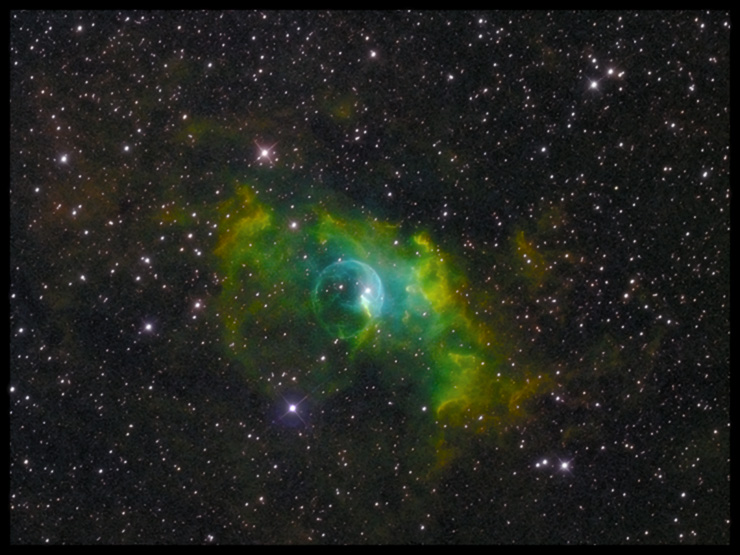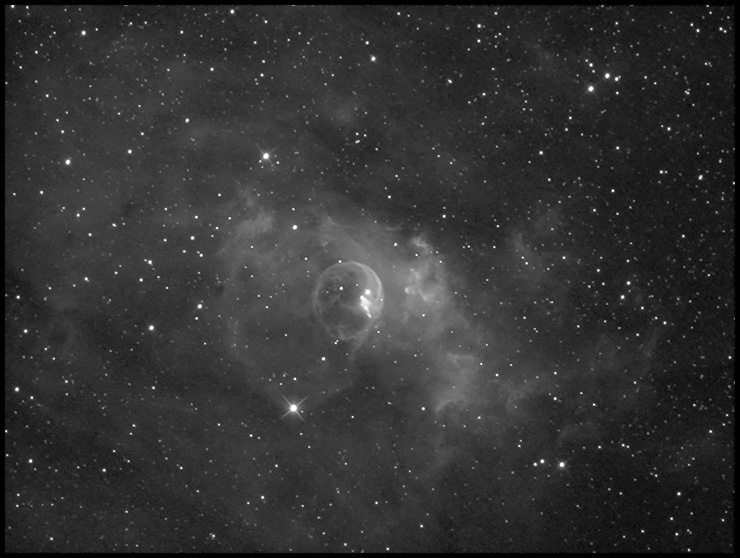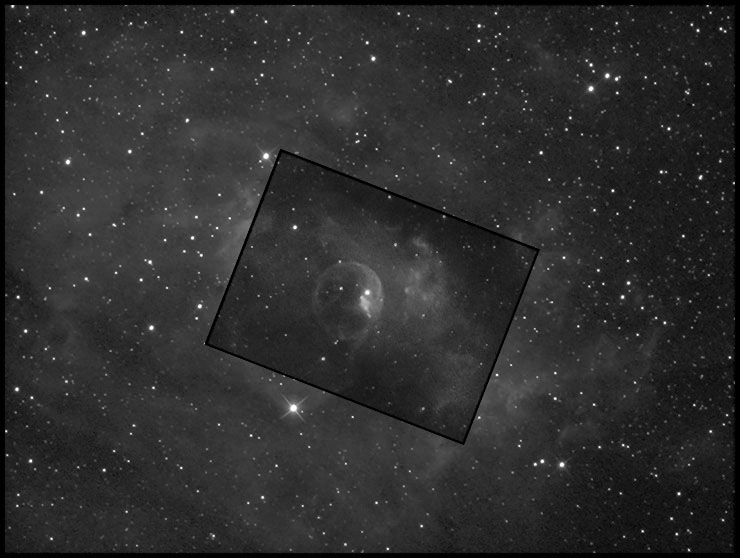12/26/2014. The Hubble Palette uses light emitted at very specific wavelengths by ionized sulphur, hydrogen, and doubly-ionized oxygen to replace the additive primaries red, green, and blue respectively. Take images through filters passing only those wavelengths and use them for what would be the red, green, and blue channels of ordinary color photographs, and you get colorful images showing the distribution of elements in emission nebulae. Because the three bandpasses are so narrow, images made in the Hubble palette are essentially immune from city light and moonlight. Thus:

NGC 7635, The Bubble Nebula in Cassiopeia
ST2000XM @ -30°C, Baader narrowband filters
5x900s Ha, 3x900s O-III, 3x900s S-II (2h 45m total)
AT10RC @ F5
Acquired, stacked and calibrated using Maxim DL
Processed in Pixinsight and Photoshop CS6
There's not a lot of signal in any but the H-a band, so O-III and S-II have been disproportionately stretched. Also, because the images live on the far left side of the histogram, noise is an even bigger problem than usual. I only had four fresh darks to use with the image above, so I am taking more overnight under increasing clouds. My H-a filter is not narrow enough to exclude ionized nitrogen (most aren't), so the distribution of elements is a little munged -- green represents both hydrogen and nitrogen. One aesthetic challenge (among many) when using this palette is keeping star colors more or less natural-looking. (Hubble bubble double trouble?) They want to go all magenta. So far, so good.
Technically, this is my second Hubble palette image. I shot a starfield in the California Nebula (NGC 1499) last night, but got such weak images through thin clouds that I'm just not going to count that. Also, there must be a way to get Pixinsight to apply flats whose FITs headers do not match up perfectly with the images to be calibrated: I use flats shot through a clear filter to map out dust on the chip and don't worry much about dust on each filter. So far, PI insists on applying only flats made through the same filter as the target image. This time, I made flats in Maxim and calibrated the images there. Finally, note that the CFW-10 is thinner than the CFW-8a, so the 0.67x A-P compressor is slightly closer to the chip, so the EFL is slightly longer than it was before. Not that it matters, really, but it needs to be measured. (Based on tonight's images, my current EFL is 1293mm, 1.18 arcseconds per pixel, F5.)
I started the night with a quick look at the same subject in RGB:

NGC 7635, The Bubble Nebula in Cassiopeia
ST2000XM @ -30°C, Baader RGB filters
6x150s each (45m total) AT10RC @ F5
Acquired, stacked and calibrated using Maxim DL
Processed in Pixinsight and Photoshop CS6
Note the improved contrast in the nebula to the right of the bubble in the narrowband image up top compared to the wideband version. I'm also a fool for pure H-a (a version made using a better dark frame to come):

NGC 7635, The Bubble Nebula in Cassiopeia
ST2000XM @ -30°C, Baader 7nm H-a filter
5x900s (1h 15m) AT10RC @ F5
Acquired, stacked and calibrated using Maxim DL
Processed in Pixinsight and Photoshop CS6
12/27/2014. The thinner CFW-10 opened up some possibilities that will be handy this spring during galaxy season. I long ago bought a 2-inch GSO achromatic Barlow but never managed to find a useful focus behind the R-C (I've been using the Barlow's body as an extension tube from time to time, but the lens has been gathering dust). Tonight, I put the Barlow lens cell on the A-P prime focus adapter. In the half hour between sunset and clouds, I found a good focus using the A-P Maxbright diagonal. (Pardon me while I make some notes that won't mean much to anyone else: the R-C's focuser is extended about 1 cm; with the diagonal turned so that the eyepiece/camera is "on top" and the CCD turned so that its cables come out in line with the OTA, the field is oriented the same as the CCD used straight-through and set to 90 degrees on the orientation scale, although mirror-reversed. Got that? I suppose I could draw a picture. Or three.) Based on a frame of NGC 7635, Maxim/Pinpoint says the EFL is 3,451mm. That's F13.5 at 0.44"/pixel which should be nice for small targets.
Here's the test image flipped around and blended with the image above, the better to compare fields of view:

NGC 7635, Test frame
ST2000XM field of view with the AT10RC @ F13.5 star-matched
with its wider field of view at F5
Here are the three CCD configurations for the R-C in one place for easy reference. This is an ST-series SBIG camera with a CFW-10 filter wheel. The CFW-10 is thinner than the CFW-8a I used to use. The thinner body makes the EFL of the fast configuration incrementally longer and slower, has no effect on the native EFL, and makes the longest EFL practical (the thicker 8a produces more amplification and moves the focal point outward out of reach without more extension than I have on hand). All these notes refer to my AT10RC and its particular focusing arrangement (stock focuser, one extension ring, and Teleskop-Services collimating ring).
EFL |
Speed |
Scale |
Notes |
| 1293mm |
F5 |
1.18" |
0.67x compressor screwed into 2 "Hyperion" rings mounted on A-P 2-inch "prime focus" adapter. No extension tube etc. Focuser extended 3.5 cm. |
| 1982mm |
F8 |
0.77" |
A-P 2" adapter. 2-inch extension tube, focuser near 4 cm? |
| 3451mm |
F13.5 |
0.44" |
GSO barlow on A-P 2" adapter inserted into 3.5" extension tube. Focuser extended 3.78 cm. |
Take note when convenient of the focuser extensions on the silk-screened scale and add them to this table -- that is, get rid of the "?"'s -- the better to take flats in evening twilight.